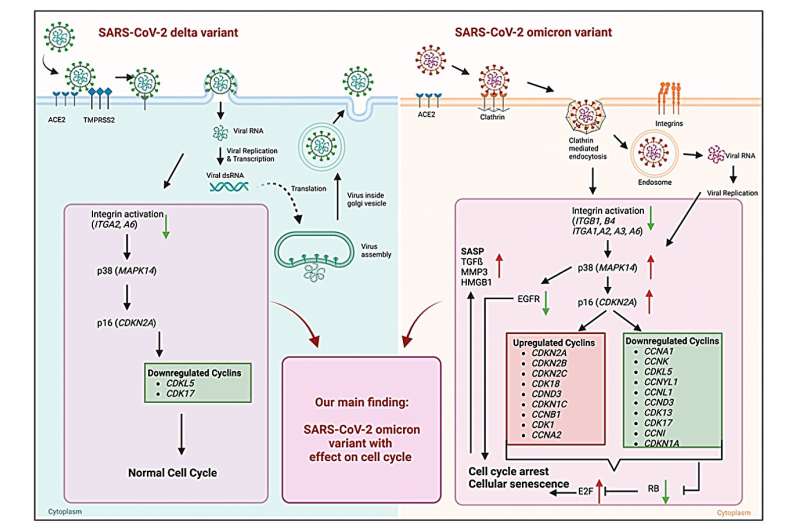This article has been reviewed according to Science X's editorial process and policies. Editors have highlighted the following attributes while ensuring the content's credibility:
fact-checked
proofread
A unique pathogenic mechanism of SARS-CoV-2 omicron variant: Selective induction of cellular senescence

SARS-CoV-2 variants are constantly emerging with a variety of changes in the conformation of the spike protein, resulting in alterations of virus entry mechanisms. Solely omicron variants use the endosomal clathrin-mediated entry.
In a new study, researchers investigate the influence of defined altered spike formations to study their impact on premature cellular senescence.
Their research paper was published on the cover of Aging, titled, "Uncovering a unique pathogenic mechanism of SARS-CoV-2 omicron variant: selective induction of cellular senescence."
"In our study, in vitro infections of SARS-CoV-2 variants delta (B.1.617.2) and omicron (B.1.1.529) were analyzed by using human primary small alveolar epithelial cells and human ex vivo lung slices. We confirmed cellular senescence in human lungs of COVID-19 patients. Hence, global gene expression patterns of infected human primary alveolar epithelial cells were identified via mRNA sequencing," the researchers write.
Solely omicron variants of SARS-CoV-2 influenced the expression of cell cycle genes, highlighted by an increased p21 expression in human primary lung cells and human ex vivo lungs. Additionally, an upregulated senescence-associated secretory phenotype (SASP) was detected.
Transcriptomic data indicate an increased gene expression of p16, and p38 in omicron-infected lung cells. Significant changes due to different SARS-CoV-2 infections in human primary alveolar epithelial cells with an overall impact on premature aging could be identified.
A substantially different cellular response with an upregulation of cell cycle, inflammation- and integrin-associated pathways in omicron infected cells indicates premature cellular senescence.
"This difference may be attributed to the distinct endocytic cell entry and intracellular pathways of the omicron variant when compared to the delta variant. The induction of cellular senescence in lung tissue following acute SARS-CoV-2 infection could potentially contribute to the reported cytokine storm and the development of long-COVID," the authors conclude.
More information: Franziska Hornung et al, Uncovering a unique pathogenic mechanism of SARS-CoV-2 omicron variant: selective induction of cellular senescence, Aging (2023). DOI: 10.18632/aging.205297



















